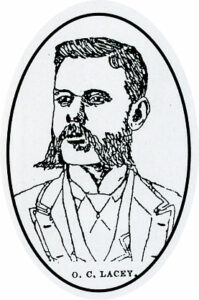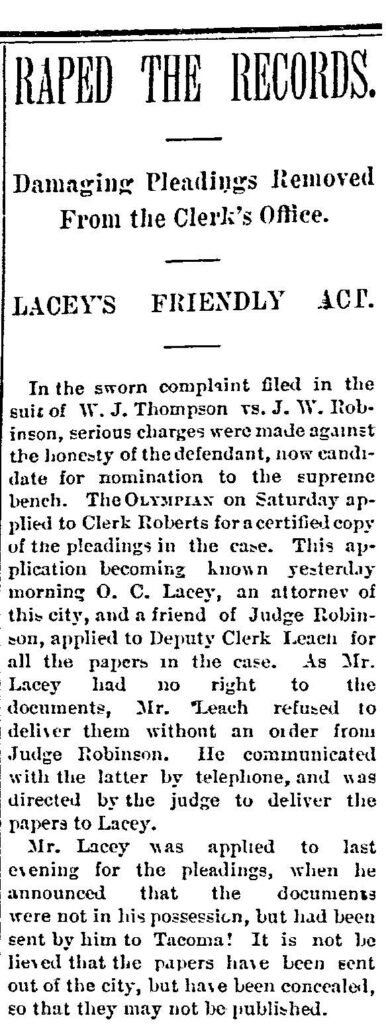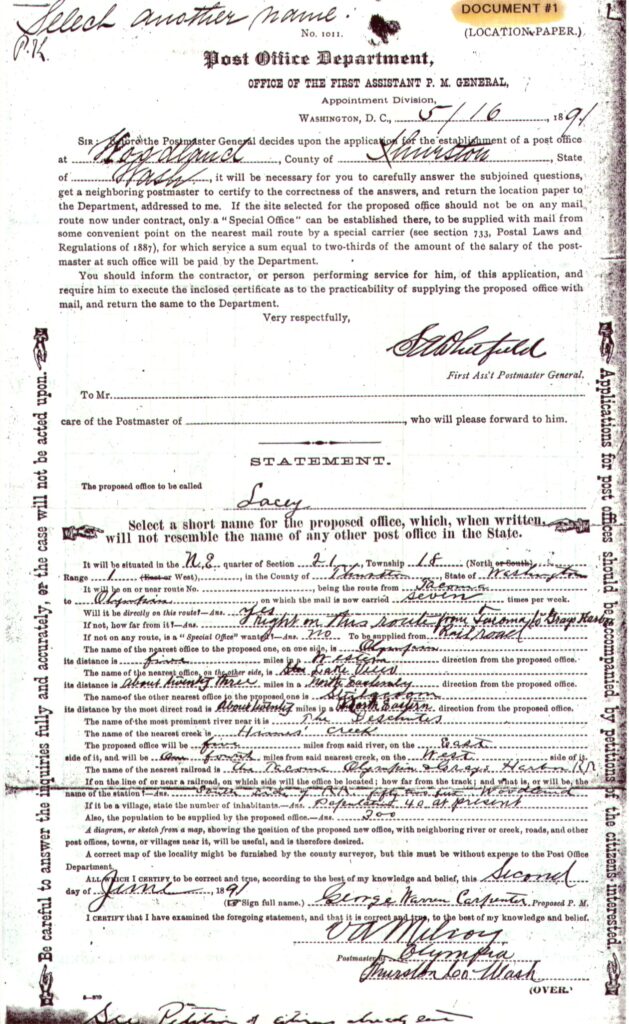Where Did the Name Lacey Come From?
One of the most frequently asked questions in the Lacey Museum is: Where did the name Lacey come from? Tradition has it that a real estate speculator from Olympia by the name of O. C. Lacey was the source. The more difficult question to answer is why his name was chosen.
Who was O. C. Lacey?

O. C. (Oliver Chester) Lacey first appeared in Olympia in 1889. The Washington Standard of February 15, 1889 reported that among the recent visitors to Olympia was a Mr. O. C. Lacey “of Chicago.” Along with his wife, Emma C., he appears in the 1889 census of Thurston County taken just prior to statehood. She is listed as 32 years old, born in North Carolina. He was 36, born in Virginia and involved with real estate. According to their 1895 divorce decree, this unhappy, childless couple had been married December 23, 1873 in Mecklenburg County, North Carolina.
The same edition of the Washington Standard that announced Lacey’s arrival also reported that Chester Lacey had opened a real estate office. This is the only reference to him in the local papers by any name other than O. C. By the summer of 1889 he had gone into partnership with another newcomer to the area, H. L. Forrest. Together they began the process of buying and selling numerous pieces of real estate in and about the city. Real estate speculation was rampant in the early 1890s and profits could be made almost overnight. Lacey and Forrest purchased a lot in the I. C. Ellis subdivision (near Fones Road) in September 1890 for $925 and sold it less than a month later for $1200. Most of their investments were either in Olympia or on the west side of Olympia. They enjoyed a modest success. Not long after they had gone into partnership, Lacey and Forrest had to move into a larger office.
Great optimism was also characteristic of the era. In 1890 Lacey went east, perhaps to go home for a visit. He returned and announced hordes of people were moving west.
In September 1891 O. C. Lacey successfully passed the bar. Since his partner Forrest was already a lawyer, they established both a real estate office and law practice. Lacey’s name appears frequently in the newspaper, involved with one activity or another, including Populist Party politics. Not all the comments made about Lacey were favorable. The Washington Standard referred to Lacey as “this poor little fly (who) lights upon the cow’s horn simply to be seen. Like his prototype he will doubtless swell up till he imagines himself an ox….” There were other references to his arrogance as well. In August 1892 the Morning Olympian reported he has removed records pertinent to a case against a friend. Lacey claimed that he had taken them to Tacoma as directed, but the newspaper accused him of hiding them. The title of the article was “Raped the Records.”
In May 1893 Lacey and Forrest dissolved their partnership, amicably it would seem. A couple of weeks after that dissolution, Lacey became Justice of the Peace. The Morning Olympian commented that, “Mr. Lacey will don his judicial garb in a few days, and that he will uphold and maintain the dignity of the bench will not be questioned.” But several months later the same newspaper took great pleasure in reporting O.C. Lacey had been kicked out of the basement of the Courthouse to make room for the County Horticultural Society.

Even though active as a judge, Lacey continued to invest heavily in real estate. In the summer of 1893 he purchased half of the Billings Addition, described by the Morning Olympian as “…one of the most valuable additions to Olympia, it being less than 1500 feet from the capitol grounds and having one of the best water fronts in the city.” The problem was that the year was 1893, the year a depression hit the Northwest, and the easy profits of just a couple of years before faded away. Lacey managed to sell very few of the lots. Fortunately for him, the real estate contract made provisions for such an eventuality and a couple of years later he quietly sold the property back to Charles Billings.
Towards the end of 1894 the newspapers reported that O. C. Lacey had gone east. They hinted that he had left for good. He lost his position as Justice of the Peace. He did return in early 1895, but spent more and more of his time outside of Washington. During his absences, he failed to care for his wife who was an invalid. Her friends convinced her to apply for divorce which was granted September 5, 1895. The divorce papers tell a tale of woe. She had been sickly almost from the moment they arrived in Olympia, but he neglected her. During his recent infrequent stays at home, he had become verbally abusive.

By January 1896 Lacey was no longer a resident of Olympia. He moved first to Seattle and in February to Spokane. Emma also moved to Seattle, but in October 1896 she returned to Olympia. O. C. Lacey had failed to provide for her as the court has directed. Impoverished and in poor health, she sought the aid of her friends, Mr. and Mrs. John R. Mitchell. She died on their kitchen floor on October 17. The Mitchells sent to Spokane to inform O. C. He could not be found.
This is the tale of O. C. Lacey.
Myth vs. Reality
There is one element missing from his story, however, and that is O. C. Lacey’s involvement with the community that would bear his name. The problem is – he had no involvement. This fact does nothing to answer the question “why?” and over the years several theories have been proposed. The stories have been printed in the newspaper and expanded upon and then printed again as the gospel truth. It is time to separate myth and reality.
| Myth | Reality | |
|---|---|---|
| 1 | O. C. Lacey acting as a lawyer for Isaac Wood, took an application for a post office to Washington D.C. | Isaac Woods died in 1869, a full 20 years before O. C. Lacey even came to Olympia. |
| 2 | O. C. Lacey, acting as a lawyer for Isaac Ellis who was about to open the Woodland Driving Park, took an application for a post office to Washington D. C. | Lacey did not become a lawyer until September 1891, two months after the creation the Lacey Post Office. However, he may had done some work for Isaac Ellis. |
| 3 | O. C. Lacey took the initiative in applying for a post office. | This is unlikely. He had no reason to, since he had no connection to this are whatsoever. The final form accepted by the Post Office Department indicates the initial petition was made by a group of citizens. |
| 4 | O. C. Lacey was interested in securing a post office for this area because he owned a lot of property here. | Lacey never owned any property in this area. The closest he came was the aforementioned lot in the I. C. Ellis subdivision. |
| 5 | When the name Woodland was rejected, Lacey secretly entered his own name and sent the application off. | The final application was signed by George Warren Carpenter, Lacey’s first postmaster. |
| 6 | Places Names of Washington State goes so far to credit Lacey with platting the city of Lacey. | There was no plat for the city of Lacey. |
A lot of the misinformation can be traced to the The Roll of the the House of Lacy, a genealogy published in 1928. The author credits Father Matthew Britt of Saint Martin’s College as their source. The book credits Lacey with drawing up the papers and suggesting his own name. It also calls him “de Lacy.” During the whole time that O. C. Lacey was in Olympia, he was never referred to as de Lacy/de Lacey nor did he sign his name that way. At one time his family might have been known as de Lacey, but O. C. was always just plain Lacey.
So What Really Happened?
The first application for a post office from this community requested that it be named Woodland. The name was not acceptable, because there was already a post office in Washington with the name Woodland. The final application with the name Lacey for the post office was accepted in June 1891. Gradually the name Lacey replaced the name Woodland for the entire community. The rest of the story is a matter of speculation.

Lacey Museum Research Files
O. C. Lacey could have carried the initial application to the Post Office Department in Washington D.C. He would have known Isaac Ellis, who was making large investments in Woodland with the race track. Olympia was small and the two men certainly would have been acquainted. Ellis is usually credited with the enticing the Olympia, Tacoma and Grays Harbor Railroad to build a depot in Woodland and with wanting a post office there too. Lacey did go east in 1890. He was originally from Virginia. If he was from northern Virginia and he went for a visit, then a stop in D.C. as a favor to Ellis would not have been too much trouble.
Lacey could have suggested his own name. The application for the post office indicated the community had to pick a short name. Lacey is certainly short. The application is signed by George Warren Carpenter. He also knew Lacey; in fact Lacey had sold him a piece of property in Olympia in 1890. The one common thread throughout all the myth is that Lacey suggested his own name.
It would not have been a big deal at the time. The name was just for the post office, not for the train station, for the school district or for the community. There were several communities in Washington with more than one name. In one community Sherlock was the post office and Maxfield the train station. Neither name survives; the community is now Nisqually. Like some other post offices, such as Bakers, Beaver, Ilkumeen and Coinmo, Lacey could have faded into oblivion. That it is now a city of over 54,000 people is just one of those quirks of fate.
Like a jigsaw puzzle with missing pieces, the story of O. C. Lacey is incomplete. We are still looking, though, and hope to solve it eventually.